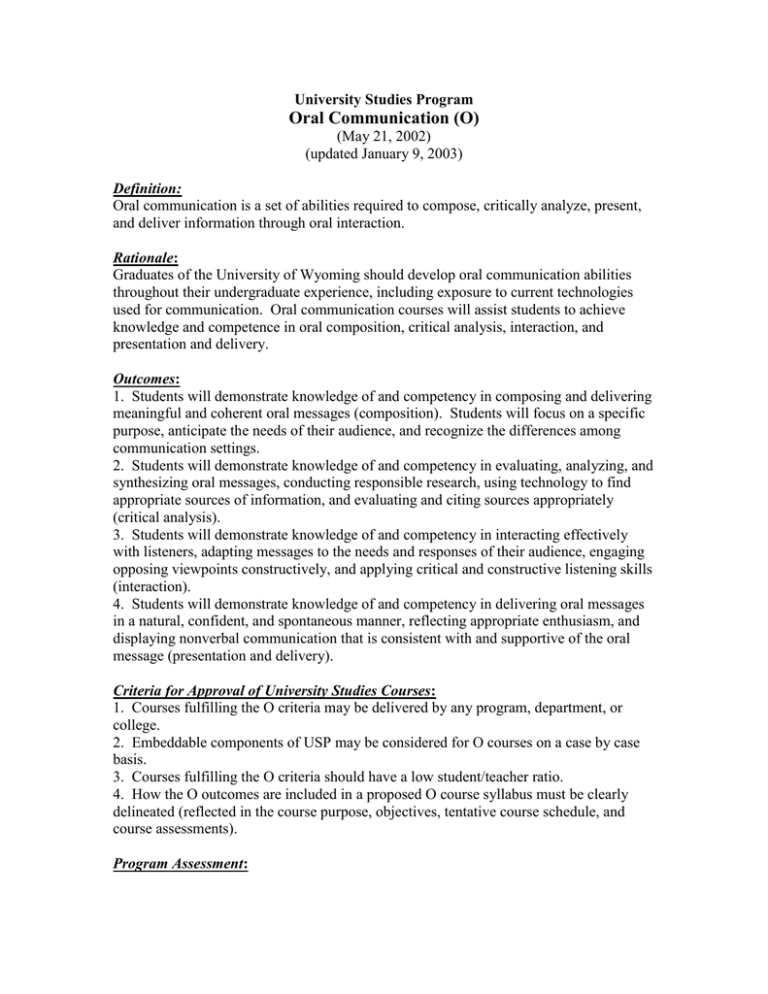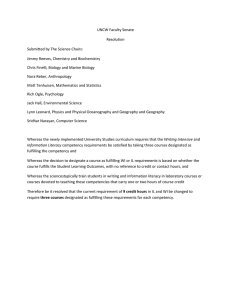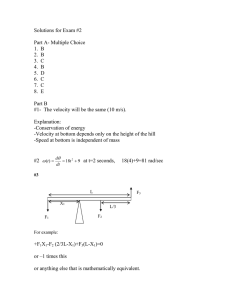Oral Communication (O)
advertisement

University Studies Program Oral Communication (O) (May 21, 2002) (updated January 9, 2003) Definition: Oral communication is a set of abilities required to compose, critically analyze, present, and deliver information through oral interaction. Rationale: Graduates of the University of Wyoming should develop oral communication abilities throughout their undergraduate experience, including exposure to current technologies used for communication. Oral communication courses will assist students to achieve knowledge and competence in oral composition, critical analysis, interaction, and presentation and delivery. Outcomes: 1. Students will demonstrate knowledge of and competency in composing and delivering meaningful and coherent oral messages (composition). Students will focus on a specific purpose, anticipate the needs of their audience, and recognize the differences among communication settings. 2. Students will demonstrate knowledge of and competency in evaluating, analyzing, and synthesizing oral messages, conducting responsible research, using technology to find appropriate sources of information, and evaluating and citing sources appropriately (critical analysis). 3. Students will demonstrate knowledge of and competency in interacting effectively with listeners, adapting messages to the needs and responses of their audience, engaging opposing viewpoints constructively, and applying critical and constructive listening skills (interaction). 4. Students will demonstrate knowledge of and competency in delivering oral messages in a natural, confident, and spontaneous manner, reflecting appropriate enthusiasm, and displaying nonverbal communication that is consistent with and supportive of the oral message (presentation and delivery). Criteria for Approval of University Studies Courses: 1. Courses fulfilling the O criteria may be delivered by any program, department, or college. 2. Embeddable components of USP may be considered for O courses on a case by case basis. 3. Courses fulfilling the O criteria should have a low student/teacher ratio. 4. How the O outcomes are included in a proposed O course syllabus must be clearly delineated (reflected in the course purpose, objectives, tentative course schedule, and course assessments). Program Assessment: The University Studies Program encourages a variety of assessment techniques. These may include: 1. Student portfolios that include works from oral communication as a part of a larger portfolio that will include student work in other USP core areas. 2. Questionnaires designed to survey students who have completed the O requirement at the end of each semester (with the focus of questions on O outcomes). 3. A sampling of student oral presentations that could be assessed live or from videotape by other faculty who teach O courses (using a standardized generic rubric). Fulfilling the Requirement: The Oral Communications (O) requirement will normally be fulfilled through one lowerdivision course of three credit hours or more. Students will also have the opportunity to fulfill the O requirement by placement if an appropriate method of evaluation is available or can be developed and if procedures/logistics for administering this evaluation method are determined feasible. Recommendations: 1. The oral communications lab housed in the Department of Communications and Journalism should be expanded to accommodate the needs of the O requirement. 2. Faculty development opportunities should be made available for instructors interested in teaching an O course. 3. Opportunity to practice communication dynamics learned in the O course should be emphasized in upper-division courses within a student’s major. 4. Students should complete the O requirement in their freshman or sophomore year. 5. Students should develop and deliver at least one substantial oral communication assignment in an upper-division course, possibly a capstone course, within their major. These presentations could tie into the assessment of the overall USP program. Process: Using the University Studies Program criteria and outcomes, a sub-committee of three selected from the membership of the University Studies Committee will evaluate each course submitted for credit within the Oral Communication category (O) and will make recommendations to the full committee. University Studies Program Criteria Review Sheet Oral Communications (O) Oral communication courses (O) will assist students to achieve knowledge and competence in composition, critical analysis, interaction, and presentation and delivery. At the end of the course students should be capable of demonstrating knowledge of and competency in: 1. composing and delivering meaningful and coherent oral messages (composition); 2. evaluating, analyzing, and synthesizing oral and written messages, conducting responsible research, using technology to find appropriate sources of information, and evaluating and citing sources appropriately (critical analysis); 3. interacting effectively with listeners, adapting messages to the needs and responses of their audience, engaging opposing viewpoints constructively, and applying critical and constructive listening skills (interaction); and 4. delivering oral messages in a natural, confident, and spontaneous manner, reflecting appropriate enthusiasm, and displaying nonverbal communication that is consistent with and supportive of the oral message (presentation and delivery). 1. For more information on O courses, please see general USP category descriptions. Course Prefix & Number: Credit Hours: Course Title: Please attach a detailed course syllabus that includes the objectives or outcomes for the course and the means to assess the extent that students reach them. List any prerequisites: What is the proposed student/faculty ratio? 1. How does the course proposal appropriately address the stated outcomes of oral communications? 2. Using information from the syllabus, please describe how this course meets the learning goals (outcomes) and criteria for the O category. A. How will students compose meaningful and coherent oral messages (composition)? B. How will the students evaluate, analyze, and synthesize oral messages (critical analysis)? C. How will the students interact with the listeners (i.e., adapt messages to the needs and responses of the audience; engage opposing viewpoints; apply critical and constructive listening skills) (interaction)? D. How will the course insure that students deliver meaningful and coherent messages (presentation and delivery)? 3. How does the course use the Oral Communications Laboratory housed in the Department of Communications and Journalism? 4. Explain how the assessment method(s) used for this course demonstrate student achievement of the learning outcomes for the O category. Explain how this assessment might provide information that can be used to improve accomplishment of desired learning outcomes. 5. Does this course include an embedded USP component? A. If yes, which embeddable component is included, and how are the outcomes of the embedded component appropriately addressed in the course proposal? 6. What other factors should the committee consider?



